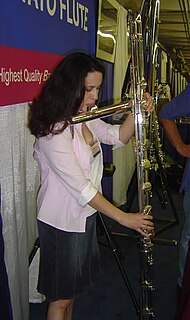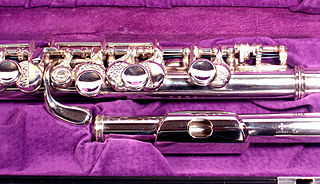Related Research Articles

The saxophone is a family of woodwind instruments usually made of brass and played with a single-reed mouthpiece. Although most saxophones are made from brass, they are categorized as woodwind instruments, because sound is produced by an oscillating reed, traditionally made out of woody cane, rather than lips vibrating in a mouthpiece cup as with the brass instrument family. As with the other woodwind instruments, the pitch of the note being played is controlled by covering holes in the body tube to control the resonant frequency of the air column by changing the effective length of the tube. The player covers or uncovers the holes by pressing keys.
Contrabass refers to several musical instruments of very low pitch—generally one octave below bass register instruments. While the term most commonly refers to the double bass, many other instruments in the contrabass register exist.

The contrabass clarinet and contra-alto clarinet are the two largest members of the clarinet family that are in common usage. Modern contrabass clarinets are pitched in B♭, sounding two octaves lower than the common B♭ soprano clarinet and one octave lower than the B♭ bass clarinet. Some contrabass clarinet models have a range extending down to low (written) E♭, while others can play down to low D or further to low C. This range, C(3) – E(6), sounds B♭(0) – D(4). Some early instruments were pitched in C; Arnold Schoenberg's Fünf Orchesterstücke specifies a contrabass clarinet in A, but there is no evidence of such an instrument ever having existed.
The bass flute is a member of the flute family. It is in the key of C, pitched one octave below the concert flute. Despite its name, its playing range makes it the tenor member of the flute family. Because of the length of its tube, it is usually made with a J-shaped head joint, which brings the embouchure hole within reach of the player. It is usually only used in flute choirs, as it is easily drowned out by other instruments of comparable register, such as the clarinet.

The contrabass flute is one of the rarer members of the flute family. It is seen often in flute ensembles, however it is recently being used in solo and chamber music situations. Its range is similar to that of the regular concert flute, except that it is pitched two octaves lower; the lowest performable note is two octaves below middle C. Many contrabass flutes in C are also equipped with a low B, Contrabass flutes are only available from select flute makers.

The contrabass saxophone is the second-lowest-pitched extant member of the saxophone family proper. It is extremely large and heavy, and is pitched in the key of E♭, one octave below the baritone saxophone.
Flute repertoire is the general term for pieces composed for flute. The following lists are not intended to be complete, but rather to present a representative sampling of the most commonly played and well-known works in the genre. The lists also do not generally include works originally written for other instruments and subsequently transcribed, adapted, or arranged for flute, unless such piece is very common in the repertory, in which case it is listed with its original instrumentation noted.
Bernard Rands is a British-American contemporary classical music composer. He studied music and English literature at the University of Wales, Bangor, and composition with Pierre Boulez and Bruno Maderna in Darmstadt, Germany, and with Luigi Dallapiccola and Luciano Berio in Milan, Italy. He held residencies at Princeton University, the University of Illinois, and the University of York before emigrating to the United States in 1975; he became a U.S. citizen in 1983. In 1984, Rands's Canti del Sole, premiered by Paul Sperry, Zubin Mehta, and the New York Philharmonic, won the Pulitzer Prize for Music. He has since taught at the University of California, San Diego, the Juilliard School, Yale University, and Boston University. From 1988 to 2005 he taught at Harvard University, where he is Walter Bigelow Rosen Professor of Music Emeritus. For his notable students, See: List of music students by teacher: R to S#Bernard Rands.
Chen Yi is a Chinese-American composer of contemporary classical music as well as a violinist. She was the first Chinese woman to receive a Master of Arts (M.A.) in music composition from the Central Conservatory of Music in Beijing. Chen was a finalist for the 2006 Pulitzer Prize for Music for her composition Si Ji, and has received awards from the Koussevistky Music Foundation and American Academy of Arts and Letters, as well as fellowships from the Guggenheim Foundation and the National Endowment for the Arts. In 2010, she was awarded an Honorary Doctorate from The New School and in 2012, she was awarded the Brock Commission from the American Choral Directors Association. She was elected to the American Academy of Arts and Letters in 2019.
Sophie Lacaze is a French composer.

The treble flute is a member of the flute family. It is in the key of G, pitched a fifth above the concert flute and is a transposing instrument, sounding a fifth up from the written note. The instrument is rare today, only occasionally found in flute choirs, some marching bands or private collections. Some 19th-century operas, such as Ivanhoe include the instrument in their orchestrations.

Donald Henry Kay AM is an Australian classical composer.
The western concert flute family has a wide range of instruments.
In music, a duodecet—sometimes duodectet, or duodecimette—is a composition which requires twelve musicians for a performance, or a musical group that consists of twelve people. In jazz, such a group of twelve players is sometimes called a "twelvetet". The corresponding German word is duodezett. The French equivalent form, douzetuor, is virtually unknown. Unlike some other musical ensembles such as the string quartet, there is no established or standard set of instruments in a duodecet.
Geoffrey Gordon is an American composer of classical music.
Igor Krivokapič is a Slovenian composer, retired tuba virtuoso and instrument inventor.
References
- ↑ Archived 2008-11-20 at the Wayback Machine , Flute Frenzy. Retrieved March 2012.
- ↑ , Eva Kingma, Flutemaker. Page regarding Contrabass Flutes. Retrieved March 2012.
- ↑ , Ron Korb, Beckett's Whisper, 2013